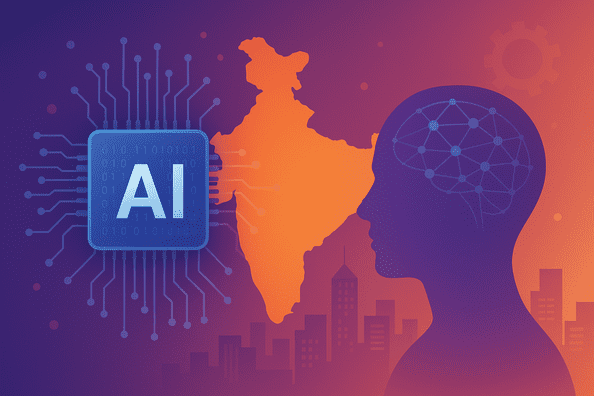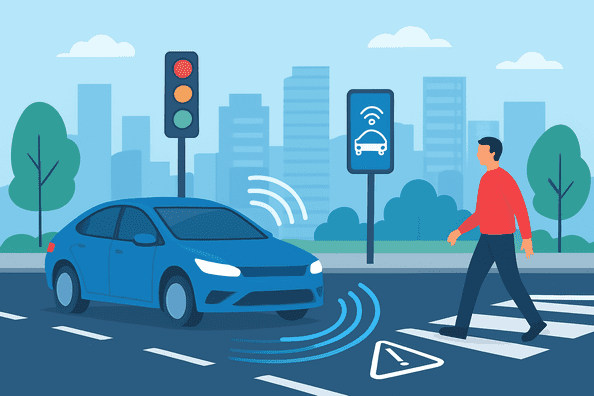Artificial intelligence (AI) has evolved from a groundbreaking research endeavor into a global powerhouse reshaping industries, economies, and everyday life. While the spotlight often falls on Silicon Valley or Shenzhen, a remarkable transformation is underway in India. RVAI stands out as a bold initiative determined to steer AI innovation from Indian soil onto the world stage. This blog delves deep into RVAI’s genesis, core philosophies, real-world impacts, challenges, and future roadmap—offering insights as if penned by an experienced insider.
The Genesis of RVAI: Why India, Why Now?
The story of RVAI begins against a backdrop of India’s meteoric digital growth. For decades, India has excelled as a global services hub, yet true innovation was often conceived elsewhere. RVAI flips this narrative by nurturing indigenous AI breakthroughs.
India’s digital ecosystem has matured rapidly. Affordable smartphones, entrenchment of the internet in rural areas, and supportive government policies—such as ‘Digital India’ and the National AI Strategy—have converged to create fertile ground for homegrown AI research. RVAI was conceived in 2023 by a consortium of Indian technologists and academicians determined to leverage this momentum. Their vision: build robust AI models and platforms tailored to India’s diversity, rather than adapting Western solutions.
Furthermore, the COVID-19 pandemic underscored the value of local innovation. India’s ability to deploy tech-driven public health solutions illustrated the potential of agile, culturally attuned AI systems. RVAI’s founding team saw a window of opportunity to institutionalize this agile ethos and channel it towards scalable AI products that serve both Indian and global markets.
Core Pillars of RVAI’s Vision
-
Indigenous Innovation
RVAI champions innovation rooted in local context. Unlike many AI efforts that focus on fine-tuning foreign models, RVAI invests heavily in research labs across Bengaluru, Hyderabad, and Pune. These labs are staffed with researchers fluent not only in Python and TensorFlow, but also in regional languages and societal nuances.
One flagship project is “BhashaNet,” a neural network trained on multilingual datasets spanning Hindi, Tamil, Malayalam, and over a dozen dialects. BhashaNet goes beyond translation—understanding cultural idioms and sentiment nuances, making chatbots and voice assistants feel more natural for millions of users.
RVAI also funds research into energy-efficient AI hardware, collaborating with local semiconductor startups to design low-power AI accelerators suited for remote areas with intermittent power. This holistic approach ensures that innovation is both high-tech and highly accessible.
-
Ethical AI and Inclusivity
Responsible AI isn’t an afterthought at RVAI; it’s woven into every stage of development. The organization maintains an Ethics Council comprising AI ethicists, social scientists, and legal experts. This council audits models for bias and privacy compliance, ensuring systems do not perpetuate societal inequities.
For example, RVAI’s facial recognition module underwent extensive bias-testing across different Indian skin tones and facial features. By publishing transparent audit reports and inviting independent researchers to test their systems, RVAI fosters accountability and public trust.
Moreover, RVAI’s inclusivity extends to workforce development. Their “AI for All” fellowship funds students from underrepresented backgrounds—women, rural youth, and persons with disabilities—providing scholarships and mentorship to become future AI leaders.
-
Scalable Solutions for Emerging Markets
RVAI recognizes the distinct needs of emerging economies and builds scalable AI solutions accordingly. In agriculture, their Agrify platform synthesizes satellite imagery, IoT sensor data, and local weather patterns to generate hyper-local crop recommendations. Smallholder farmers, previously dependent on generic advisories, now receive tailored guidance via simple SMS alerts in their native language.
In healthcare, RVAI’s radiology AI has been deployed in rural clinics across Uttar Pradesh and Bihar. By compressing models to run on standard laptops, RVAI ensures early disease detection without expensive GPU farms. Local community health workers upload X-rays via offline apps; the AI provides rapid feedback, enabling timely referrals.
Education is another focal point. RVAI’s “LearnSmart” adaptive learning engine analyzes students’ performance to deliver customized lesson plans. In pilot programs across Jharkhand, students using LearnSmart saw a 25% improvement in STEM comprehension within six months. These successes illustrate how scalable AI can uplift underserved populations.
Real-World Examples of RVAI in Action
AI-Driven Agriculture
RVAI’s collaboration with state agriculture departments has catalyzed a smart farming revolution. By integrating drone surveillance, mobile soil sensors, and machine learning, RVAI helps farmers detect pest outbreaks and soil nutrient deficiencies days before visible symptoms appear. One case study in Maharashtra reported a 15% yield increase for soybean farmers, alongside a 20% reduction in pesticide use—translating into both economic and environmental benefits.
Additionally, RVAI’s predictive analytics tools have informed government crop insurance schemes. By accurately forecasting yield risks based on granular weather data, insurers can offer fairer premium rates, ultimately boosting farmers’ financial resilience.
Healthcare Diagnostics in Rural India
In regions where specialist doctors are scarce, RVAI-backed diagnostic kiosks have emerged as lifelines. Positioned in primary health centers, these kiosks feature AI-powered image analysis for conditions like tuberculosis, pneumonia, and diabetic retinopathy. Early adopters in Rajasthan reported a 40% reduction in diagnostic turnaround time, helping initiate treatment sooner and reducing disease transmission rates.
Beyond diagnostics, RVAI is piloting AI-driven telemedicine bots capable of triaging symptoms in local languages. These bots route patients to appropriate care pathways—vital in areas where travel to tertiary hospitals can take hours.
Multilingual Educational Platforms
RVAI’s education initiatives address linguistic diversity head-on. Their platform supports personalized curricula in over 12 Indian languages, blending AI-generated content with locally relevant examples. For instance, a mathematics lesson might reference regional market scenarios or local festivals to illustrate probability concepts, making learning more engaging and relatable.
Teachers also benefit from AI-driven analytics that highlight class-wide learning gaps. This empowers educators to tailor in-person instruction, optimizing both remote and classroom experiences simultaneously.
Challenges and Balanced Perspectives on RVAI
Talent Drain and Skill Gaps
Despite India’s vast talent pipeline, specialized AI researchers remain in short supply. Leading universities are racing to expand AI programs, but the demand for PhD-level expertise often outpaces supply. Many top graduates still pursue opportunities abroad, attracted by established research labs and higher compensation.
RVAI counters this by offering competitive research grants and forging industry-academia partnerships. Their “Reverse Brain Drain” initiative invites expatriate researchers to lead projects in India, offering dual-affiliation with global institutions to maintain international exposure.
Infrastructure and Data Privacy
AI development demands both computational power and robust data ecosystems. While cloud infrastructure is expanding in India, bandwidth limitations and high costs for GPU instances can bottleneck research. RVAI is addressing this by investing in regional AI compute hubs that provide subsidized resources for emerging start-ups and academic labs.
On the data front, privacy regulations like the proposed Personal Data Protection Bill introduce compliance complexities. RVAI maintains a Privacy-by-Design framework, anonymizing datasets and employing federated learning to train models without centralized data pooling—balancing innovation with citizens’ rights.
Ethical Concerns and Bias
No AI system is entirely free of bias. RVAI’s ongoing challenge lies in continuously auditing and refining models as new data and use cases emerge. Their proactive stance—publishing bias metrics, hosting hackathons for external audits, and maintaining open-source code for scrutiny—demonstrates commitment but also underscores the iterative nature of ethical AI.
Personal Insights: What RVAI Means for India and the World
Observing RVAI’s journey offers a compelling narrative of how technology can be culturally contextualized. Rather than transplanting solutions, RVAI adapts AI to local realities—challenging the one-size-fits-all approach. This philosophy resonates globally; as emerging markets seek AI solutions for unique issues—be it in finance, education, or public services—RVAI’s model serves as a blueprint.
Moreover, RVAI embodies a shift towards inclusive innovation. By championing diversity in research and prioritizing underserved communities, it ensures that AI advances don’t exacerbate inequality but instead bridge existing gaps. For global stakeholders, collaborating with RVAI means tapping into scalable, ethically grounded AI that aligns with sustainable development goals.
Looking Ahead: The Roadmap for RVAI
RVAI’s strategic plans for the next five years include:
- Global Research Collaborations: Partnering with top universities in Europe, North America, and Asia to co-develop next-generation AI frameworks.
- AI Hardware Ecosystem: Expanding partnerships with domestic semiconductor firms to produce cost-effective AI accelerators tailored for local needs.
- Workforce Development: Launching nationwide AI bootcamps and accredited certification programs, aiming to train 100,000 AI practitioners by 2030.
- Policy Advocacy: Contributing to national and international AI policy forums, influencing regulations that balance innovation with societal safeguards.
- Open-Source Platforms: Releasing core RVAI models and toolkits under permissive licenses to spur community-driven enhancements and wider adoption.
These initiatives underscore RVAI’s commitment to scalable growth, ensuring that India not only keeps pace with global AI trends but also sets new benchmarks.
Conclusion
RVAI is more than an AI initiative—it represents India’s aspiration to be a global architect of the AI revolution. By fusing indigenous innovation, ethical stewardship, and scalable solutions, RVAI charts a path where technology amplifies human potential and fosters equitable progress. As its projects mature and partnerships deepen, RVAI’s blueprint will illuminate how emerging economies can lead the AI frontier, offering invaluable lessons for the world.



